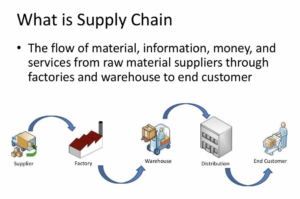I briefly went over what dropshipping is, but you might not know exactly how it works. So here’s a step-by-step overview of the entire dropshipping process. I’ll go over what it looks like behind the scenes, and I’ll also look at what the customer experiences (and why it matters).
Understanding the supply chain
In this guide, you’ll see the term ‘supply chain’ a lot. It sounds like fancy industry lingo, but it simply refers to how a product moves from supplier to customer. We’ll use this to discuss the dropshipping process.

You, the retailer, are just one piece of the puzzle. A successful dropshipping operation relies on multiple parties all working together in sync. The supply chain is exactly that: the coordination of the manufacturer, supplier, and retailer.
The supply chain can be broken down into 3 basic steps:
1. The manufacturer creates the products and sells them in bulk to suppliers and wholesalers
Let’s say Manufacturer A makes water bottles. After the bottles roll off the production line, they’re sold in bulk to suppliers and wholesalers, who turn around and resell the bottles to retailers.
2. Suppliers and wholesalers sell the products to retailers.
A retailer like yourself searches out a supplier for a specific type of product. The retailer and supplier then enter into an agreement to work together.
A small note here: while you can buy directly from product manufacturers, it’s often much easier to purchase from suppliers instead. Most manufacturers have minimum purchase requirements that can be rather high, and you’d also have to store, stock, and ship the products.
So it might seem simpler to buy straight from the manufacturer, but you’ll benefit most from buying from suppliers (and dealing with the slight markup).
Suppliers are also convenient because many of them specialize in a certain niche, so you can easily find the kind of products you need. This also means you can get started selling super quickly.
3. Retailers sell the products to consumers.
Suppliers and wholesalers do not sell directly to the public; that’s the retailer’s job. The retailer is the final step between the product and the consumer.
Retailers provide online storefronts from which consumers purchase products. After the product has already gotten marked up by the wholesaler, the retailer marks it up yet again to arrive at the final price. By ‘mark-up’, we’re referring to setting a price that covers the cost price of the item and brings you a profit.
That’s it! That’s the entire supply chain from start to finish. It’s a straightforward but crucial concept in business.
You might have noticed that I didn’t refer to any specific party as a dropshipper. That’s because ‘dropshipper’ is not a specific role. Dropshipping is simply the action of shipping products for someone else. Manufacturers, suppliers, and merchants can all technically be dropshippers.
In this guide, I’m going to cover how to start a dropshipping retail business. In other words, I’ll show you how to become the merchant that purchases products from wholesalers to sell to the public. This could mean you sell via eBay or your own website with an online storefront.
Now that you know what the supply chain looks like, consider what it’s like for the customer.
What the customer experiences
You’ve bought products online hundreds of times before, but you’ve probably never thought about the experience. It’s second nature for consumers. As a customer, you don’t need to think about it, but as a retailer, you absolutely should.
Retailers can learn a lot by thinking about the ideal customer experience of ordering from a retailer. This may seem obvious, but if there are any snags in the customer experience, it could spell trouble for you as a retailer. It’s important to know what your buyers expect.
For the sake of explanation, let’s pretend you have a business called Fancy Water Bottles, a site called FancyWaterBottles.com, and a wholesaler called Water Bottles Worldwide. Here’s what the ordering process would look like from the customer’s perspective:
1. Customer A places an order for a water bottle on FancyWaterBottles.com and immediately receives an email confirmation of the purchase.
2. After a few hours to a couple of days, Customer A receives a notification that their order has shipped. The notification includes tracking information so Customer A knows exactly where their package is while en route.
3. Customer A receives the water bottle.
It’s the same process you’ve gone through each time you’ve purchased anything online. This seems basic, but there are two important aspects of this experience.
First, it’s simple. All the customer has to do is order the product and pay for it. Everything else, like an order confirmation email and tracking information, is handed to them on a silver platter.
And that brings me to my second point: convenience. The buying experience is extremely convenient in every way. An online purchase takes just minutes to make, and customers can browse any retailer’s site at their leisure. And if all goes well, the customer won’t even have to interact with anyone. It takes the minimum amount of effort to achieve the desired result of getting a product.
This experience is a lot like buying a water bottle at a big box store and using the self-checkout. It’s a no-fuss process that doesn’t present any problems. This is a big reason why people buy online in the first place, so your storefront has to give your customers that same level of convenience.
Last but not least, the customer should never notice that any other parties besides the retailer are involved. Think about it. When you buy something online, you think, “I bought a water bottle from Fancy Water Bottles.” You don’t consider where the retailer got the product or who might be shipping your order.
To make the process seamless, the customer shouldn’t be aware of all the stops their product makes. The package they receive will have your retail name on it, so as far as the customer is concerned, you fulfilled and shipped the order.
This is how the dropshipping process should ideally look from the customer’s point of view. Now let’s break down what happens on the other end.
What happens behind the scenes
That’s what the customer sees, but what is dropshipping like behind the scenes?. Here’s an overview of the process:
1. Customer A places an order for a water bottle on FancyWaterBottles.com and receives an email confirmation of the process. Let’s say the total came to $14.95. Fancy Water Bottles receives the same email confirmation as well as Customer A’s payment. This is usually made possible by automated software that sends out the confirmation to both buyer and seller.
2. Fancy Water Bottles sends the order to Water Bottles Worldwide. Typically, a sales representative from Water Bottles Worldwide will receive and process the order. The retailer will then be charged for the purchase. For this example, let’s say Water Bottles Worldwide charges $12.95 for each water bottle. The retailer will pay that amount, and the difference is the profit the retailer will make. In my example, the retailer will net a profit of $2.00.
3. Water Bottles Worldwide packs up the order. Although the wholesaler ships the product, the package will be addressed from Fancy Water Bottles, and the Fancy Water Bottles name will appear on the invoice and packing slip. (This is so the customer will recognize the retailer’s name on the package.) The wholesaler then sends an invoice and tracking information to the retailer.
4. The retailer sends along the shipping information to the customer. This finalizes the retailer’s role in the order process.
5. The customer receives the package and enjoys the water bottle.
That’s the supply chain in action. You can see how the retailer, wholesaler, and manufacturer all have to work together flawlessly. When done right, it’s a smooth process that results in minimal work for everyone involved
One point I want to stress is that you, the retailer, are responsible only for two steps: sending orders to the supplier and shipment information to the consumer. Sometimes, you’ll have to be responsible for other things like customer support, but if everything goes smoothly, those two steps are all you have to do.



